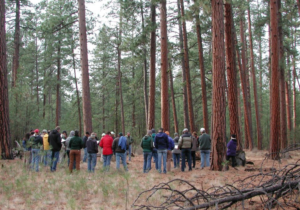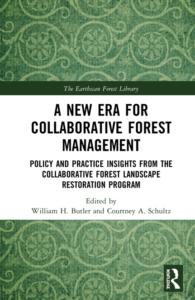By William Butler for EDRBlog.org

Dr. Courtney Schultz of Colorado State University and I have been researching and engaging with professionals involved in the Collaborative Forest Landscape Restoration Program (CFLRP) for almost a decade now. This program offers an extraordinary opportunity to explore questions of collaborative governance in public lands management involving multiple cases over a long time period. CFLRP requires collaboration throughout planning, implementation, and monitoring of national forest restoration projects, joining agency staff and interested stakeholders in what we’ve characterized as a sort of decade-long restoration marriage. Dr. Schultz and I recently completed a just-released edited volume, A New Era for Collaborative Forest Management, exploring the various aspects of collaboration through an examination of the 23 cases involved in CFLRP.

This book identifies lessons learned for governance and policy through a new and innovative approach to collaborative forest management by offering the social science and policy researcher perspective. We examine questions about collaborative governance processes and the dynamics of trust, accountability and capacity; how scientific information is used in making decisions and integrated into adaptive management processes; and the implications and dynamics of engaging in collaboration through implementation. Moreover, we identify practice and policy implications of the work.
One of the underlying tensions we explored in our book is that the CFLRP mandates collaboration in a lands management context where agency authority and responsibility are rather clearly laid out in the law, but not easily shared. This led to some accountability problems and disgruntled stakeholders, especially early on when the agency spent implementation dollars on short timelines often without sufficient input from collaborative groups. On some projects, these challenges continued over the 10-year timeframe, and stakeholders felt that communication did not occur at the levels they expected. But, over time, the processes on each landscape evolved and, in a number of places, led to some rather extraordinary accomplishments on large scale project planning, creative and effective restoration implementation, and inclusive multi-party monitoring.
Get notified when new articles are posted to the EDR blog – sign up for our email list »
Part of what fostered restoration achievements was deeply tied to the relationships between collaborative partners and the Forest Service. It is no surprise that relationships can either facilitate or stall progress in collaboration and while we explore these different relationships throughout the book, concepts of trust and accountability feature prominently. Trust is a multifaceted concept and involves not only interpersonal trust, but also trust in systems, organizations, and procedures. Trusting relationships were over and over again the grease on the wheels of restoration agreements and actions. Diverse types of trust can help collaborative processes weather changes over time, and the concepts in this book shed light that can help agency personnel and stakeholders manage through times of transition, limited capacity, and personnel turnover. The idea of accountability is often associated with punishment and compliance, but in the case of collaboration, relational accountability motivates many actors to perform their tasks in support of the collective. These findings are contextual and dependent upon the characteristics and interactions of actors involved. And yet, our book reveals that there are ways to help strengthen relationships, such as repeated interactions in various types of settings; focusing on common tasks and building shared experiences; and designing collaborative groups to legitimize the diversity of voices within them.
We discovered that to have effective collaboration, capacity or the lack thereof, arose repeatedly as a key issue. Limitations on time, money, and staff created barriers to effectiveness. But, collaborative capacity goes beyond these essential resource constraints or enablers. Participants needed to be able to have capabilities both as restoration professionals and collaborative participants. Building these capabilities often involved sharing ideas and lessons learned between collaborative groups—establishing a collaborative of collaboratives as it were. Boundary and bridging organizations were key to organizing these groups and making sure that both technical expertise and collaborative expertise were nurtured in various forums. A deeper investigation of learning within and among groups will be an exciting area to further research, especially regarding monitoring and adaptive management and the application of new knowledge to restoration practice.
Our research also contributed to understanding the dynamics that arise when undertaking collaboration through the implementation phase. Herein lies a key tension—once the plan lays out the vision, how can we work together when responsibility falls on the shoulders of a public agency? Many of the CFLRP groups figured out ways to navigate that tension and contribute to these projects on various levels, often indirectly, but in substantive ways. In many cases, CFLRP groups broadened the time and space within which adaptive management could occur. In a few cases, CFLRP groups ended up out in the field together, working on joint projects for restoration. However, the research reveals that limited agency capacity, individual leaders or partners, staff turnover, and challenges on the industry capacity side of the equation are all factors that could stymie project progress.
Our goal was to make the research relevant to public agency personnel at all levels, participants within collaborative groups, and policy makers who shape the legal context within which collaborative public lands management occurs. Each chapter has a section on practice and policy implications to make sure that the research is relevant to those working in the field.
There are many lessons derived from this body of work and we have shared some of those overarching findings here. However, there is much more to be learned from research on large scale, long term, collaborative landscape restoration efforts. In a time when uncertainties are growing, divisiveness is the order of the day, and climate change is impacting ecological integrity throughout the world, the need for adaptive visions for resilience, collectively determined trajectories, and effective ways of working together over the long term could not be more important. Through the study of these long term landscape scale collaborative groups participating in CFLRP, we offer applicable lessons that can help shape a future in collaborative environmental management that is based on adaptive management, resilience, ecological integrity, learning, and collective action. In doing so, we share a message of inspiration, hope, and technique that demonstrates how we can work together effectively to respond to complex problems in productive ways even when we come to the table with differing views about how to get there.
The book is available in eBook and hardcover formats currently with an author discount.

William Butler is an Associate Professor and MSP Program Director at the Department of Urban & Regional Planning at Florida State University. His teaching and research interests focus on collaborative environmental planning and management. He co-authored the forthcoming book A New Era of Collaborative Forest Management with Dr. Courtney Schultz of Colorado State University.
